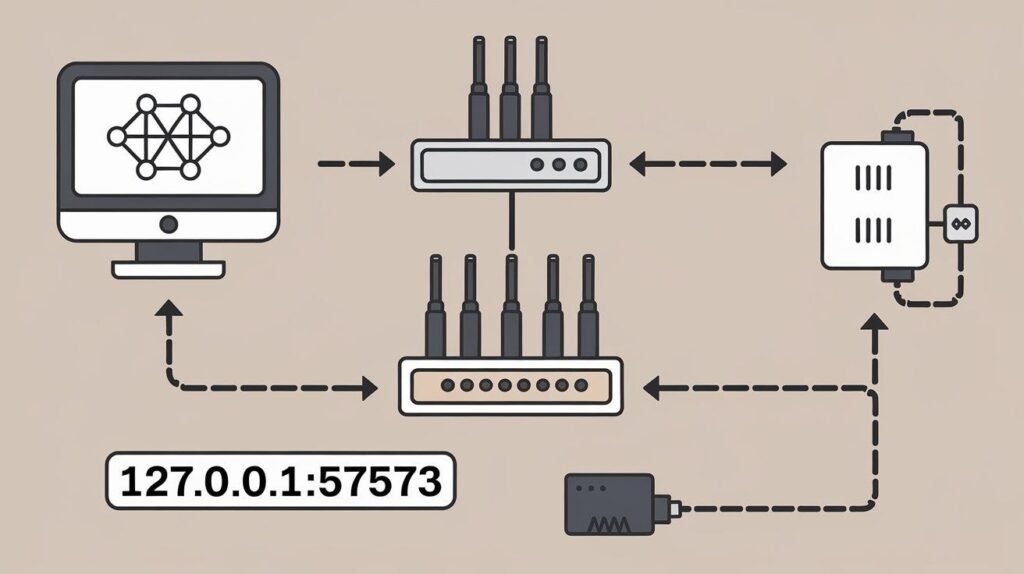Introduction to 127.0.0.1:57573
The IP address 127.0.0.1, often referred to as “localhost,” plays a critical role in networking and development environments. When combined with the port number 57573, it forms a specific address that has practical importance in application testing, development, and network configuration. While this IP may seem mysterious to those new to network configurations, it is an integral part of how software communicates within a single machine.
At first glance, it might look like a random set of numbers, but there is a lot to unpack regarding how 127.0.0.1:57573 works. This article will dive deep into understanding the localhost concept, the importance of port numbers, and how they work together for developers and system administrators. Whether you’re a beginner or have some experience, this guide will clarify everything you need to know about 127.0.0.1:57573.
What is Localhost? Understanding 127.0.0.1
Localhost, often represented by 127.0.0.1, is essentially a loopback address in networking. This address allows communication within the same machine without the need to access external networks or the internet. It’s like creating a closed loop where the machine sends data to itself as if it were sending it out into the network.
Origins and Purpose of Localhost
The concept of localhost originated to simplify networking protocols, enabling developers to test services and applications locally without exposing them to the broader internet. By default, all operating systems reserve 127.0.0.1 as the loopback IP address, which means any network traffic destined for this address stays within the system. It allows developers to test networking applications without dealing with external variables like internet speed, firewalls, or network security.
For example, when a web developer runs a server on 127.0.0.1, it’s only accessible locally, meaning the traffic never leaves the computer. This is particularly useful in development environments where exposing your application to the outside world can pose security risks or unnecessary complications.
How Does Localhost Work?
When you type 127.0.0.1 in your browser’s address bar, the request is sent to the local machine, instructing it to communicate with itself. This is different from external IP addresses, which guide the request out onto the internet or network. Localhost isolates that communication, which makes it ideal for debugging, learning, and application testing.
In networking, this process is called loopback. The machine’s network stack recognizes 127.0.0.1 as its own address and processes the request internally. Since there’s no real external network involved, the latency is virtually zero, allowing for fast responses—perfect for rapid testing environments.

The Role of Port Numbers in Networking
In any computer network, ports are essential to differentiating between various services running on the same IP address. When using 127.0.0.1, the system needs to know which specific service you are trying to access, and that’s where the port number comes into play. Think of the IP address as the street address of a building and the port number as the apartment or office number within that building.
What is a Port Number?
A port number is a 16-bit number that identifies a specific process or service on a computer. In the case of 127.0.0.1:57573, 57573 is the port number, and it’s used to direct traffic to the correct service running on the localhost. Without port numbers, it would be impossible to run multiple services or applications on the same IP address, as there would be no way to differentiate between them.
Ports can range from 0 to 65535, with certain ranges reserved for well-known services. For instance, port 80 is reserved for HTTP traffic, and port 443 is for HTTPS traffic. Ports above 1023 are typically available for general use, which is why the port 57573 can be freely assigned to a local application or service.
How Do Ports and IP Addresses Work Together?
When you open a connection to a server, your computer needs to know where to send the traffic. The IP address tells the network which device or server to send the data to, while the port number tells the server which service or application to pass the data to.
In the case of 127.0.0.1:57573, the 127.0.0.1 address tells the machine to loop the traffic back to itself, and the port 57573 directs it to a specific service, such as a locally running web server, database, or other software. This makes the combination of an IP address and port number an essential element of network communication.
Understanding the Loopback Address 127.0.0.1 in Development
When working on software development, especially web-based applications, 127.0.0.1 is commonly used to host servers locally. This setup allows developers to test applications in a safe and controlled environment without needing to expose them to the wider internet or local network.
Why Developers Use 127.0.0.1 for Testing
When creating a web application, developers typically set up a local web server to test their code. The web server is usually hosted on 127.0.0.1 so that the developer can access it through a browser by entering 127.0.0.1 or localhost in the address bar. The developer can see how the application behaves in real-time without needing to worry about external factors.
Additionally, using localhost ensures that sensitive development data is kept private and secure. There’s no risk of anyone outside the local machine accessing the server or application, making it an ideal environment for experimentation and debugging.
Common Services and Applications Using Localhost
Several software tools and frameworks depend on 127.0.0.1 during their development and deployment phases. Popular web development environments like XAMPP or WAMP use localhost to serve websites locally. Similarly, developers working with frameworks like Node.js, Django, or Ruby on Rails will frequently set their local server to run on 127.0.0.1.
By default, many database management systems such as MySQL or PostgreSQL bind to 127.0.0.1 to ensure that they are only accessible locally. This is a common security practice to avoid exposing critical databases to the internet unintentionally.
What Happens on Port 57573?
The port 57573 doesn’t correspond to any specific service or protocol by default. It falls within the range of ephemeral ports (also known as dynamic or private ports), which are usually used by client-side applications for temporary communication. These ports are not reserved by any standardized protocol, so they are generally available for any application to use during runtime.
Why Choose a High Port Like 57573?
Higher port numbers (like 57573) are typically chosen to avoid conflicts with common services. For example, as mentioned before, port 80 is used for HTTP, and port 443 is used for HTTPS. By choosing a port like 57573, developers ensure that their service won’t conflict with these reserved or well-known ports.
In development and debugging environments, using a high-numbered port is a common practice because it reduces the risk of port collisions. Since fewer services or applications use high ports by default, it allows developers to run multiple services simultaneously without conflicts.
Custom Service Binding to Port 57573
If you see 127.0.0.1:57573 in action, it likely means that a specific service or application is running on that port. It could be a custom-built web server, an API endpoint, or even a game server in development. The important thing is that this port is dynamically allocated and serves a local service that needs a unique identifier on the machine.
